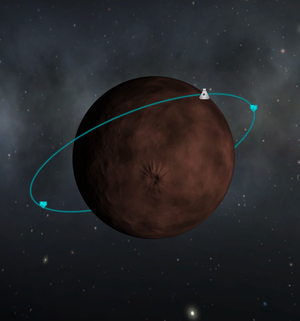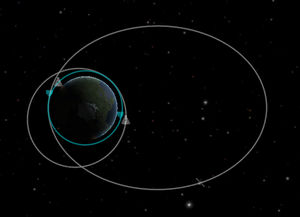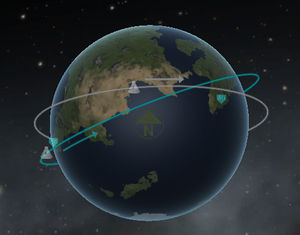Orbit/hu

A "keringési pálya" egy elliptikus útvonal az égitest körül[celestial body]. A pálya azon pontját, amely legközelebb áll a körülkeringett égitesthez "periapszis"-nak és a legtávolabbi pontját "apoapszis"-nak nevezzük. Ezek a pontok egyenként jelölve vannak a térkép nézeten mint "Pe" és "Ap".
A Pályát "stabil"-nak nevezzük, ha minden pontja a körülkeringett égitest felszíne és légköre felett van, ezt egyszerűbben értelmezve a periapszis a légkör és az égitest legmagasabb pontja felett van, lévén a periapszis a legalacsonyabb pontja a pályának. Az űrjármű ilyen pályán nem veszíti el a sebességét a légellenállás miatt, és nem ütközik a felszínnek.
Hogy elérjünk egy pályát, az űrjárműnek el kell érnie egy elégséges magasságot és pályasebességet. Az emelkedés közben egy gravitációs forduló segít elérni ezeket a célokat üzemanyag-takarékosan. Utána az alap manőverekkel[basic maeuver] már könnyen változtatható a pálya alakjait.
Contents
Tulajdonságok
Minden pályának van néhány alaptulajdonsága amely jellemzi. Ez a lista tartalmaz több olyan értéket, amely a lista más értékeiből is számítható.
Apoapszis és periapszis
- → Lásd még: Apsis on Wikipedia
Az apszisok határozzák meg a pálya legközelebbi és legtávolabbi pontjait. A periapszis a legalacsonyabb pontja a keringési pályának és hasznos meghatározni, hogy elég magas-e ahhoz, hogy hogy ne ütközzön a felszínbe, vagy ne keresztezze a légkört. A túloldalon az apoapszis található ami a körülkeringett égitesttől legtávolabb lévő pontja a pályának. A térkép módban a periapszis nem látható, ha az a felszín alatt. Zavart okozhat hogy az apszisokat honnan mérjük. A játék a felszíntől számítja, míg a pályamechanika számára a tömegközépponttól számított értékek a mérvadóak. Az űrjármű az apoapszitól a periapszis felé haladva süllyed, míg a periapszistóla az apoapszis felé haladva emelkedik.
A parabolikus és hiperbolikus pályák hatásgöbön kívüli apoapszisai soha se látszódnak. Apoapszisok más hatásgömbökben lehetségesek. A jelenlegi pálya periapszisa csak akkor látszódik, ha a jövőben haladunk át rajta, amint áthaladtunk rajta eltűnik. Ez független attól, hogy a pályának más hatásgömbben lehet apoapszisa vagy periapszisa(például egy hintamanőver után egy nagyobb égitest hatássugarába kerülve befogja).
A tökéletes kör pályán nem lehet meghatározni az apszisokat. A magasság a kör pályán nem változik, ami szükséges lenne az apszisok meghatározásához. Ez azonos a fél-nagytengellyel, ha középpontból mérjük. Elliptical orbits have usually both apsides and only no periapsis if it is below the surface. If an orbit is almost circular it is usually treated as perfectly circular where both apsides and the semi-major axis are identical if measured from the body's center.
Sometimes there are special words used for the different bodies. Apokee or apokerb for the apoapsis of an orbit around Kerbin and similar perikee or perikerb for the periapsis around Kerbin.
In Kerbal Space Program the apsides are usually abbreviated to “Ap” and “Pe” which corresponds with the two markers on the orbit. In real world science an uppercase Q is used for apoapsides and a lowercase q for periapsides because variables usually only contain one letter. Using a for the apoapsis is not recommended as it can generate confusion with the semi-major axis which usually uses that variable name.
Eccentricity
- → Lásd még: Orbital eccentricity on Wikipedia
The eccentricity gives how elongated the orbit is. There are different eccentricities, although usually the orbital eccentricity is used for orbital mechanics. It can categorised in four categories:
- In a circular orbit the eccentricity is exactly 0
- In an elliptical orbit the eccentricity is between 0 and 1
- In a parabolic orbit the eccentricity is exactly 1
- In a hyperbolic orbit the eccentricity is above 1
If the eccentricity is above or equal to 1 the orbit is escaping the body. Circular and parabolic orbits are not common if not impossible, as the maneuvers have to be extremely precise. But it is possible to get the eccentricity very close to the value which can then be considered as circular or parabolic. Some planets and moons in Kerbal Space Program have perfectly circular orbit. This is possible because they move on “rails” so no physical interaction can change the properties.
The eccentricity is usually abbreviated by a lowercase e.
Inclination
- → Főcikk: Orbital inclination on Wikipedia
The tilt of the orbit is given by the inclination. Usually the value is given in degrees where the value is given between –90° and 270°. An inclination of 0° or 180° is equatorial, so the craft is always above the equator. An inclination of 90° is characteristic for polar orbits. When the inclination is below 90° the orbit is prograde, meaning the rotation around the body is the same as the rotation of the body. An inclination above 90° and below 270° determines a retrograde orbit which orbits the other way around. As all bodies in the Kerbol System are rotate counter-clockwise, seen from the North pole, all prograde orbits are counter-clockwise and all retrograde orbits are clockwise.
Depending from the starting location the directly available lowest inclination is limited to the latitude. A polar orbit is always possible, while for equatorial orbits the craft has to start from the equator. As the Kerbal Space Center is near the equator it is possible to launch into almost all inclinations without additional orbital manuevers.
While a polar orbit, and depending on the altitude and coverage also near polar inclinations, covers a complete body, rendezvous with an object in a equatorial orbit is usually easier. The inclination is exactly the range of latitudes the craft will pass over in both (North and South) direction.
There is currently no direct way to determine the inclination without using mods. For some planets it is possible to determine the inclination if the planet is orbited by a moon with no inclination. The moon can then be targeted and the angle given at the ascending and descending node are the inclination. This is also possible for an orbit around Kerbol. The “moon” with no inclination is then Kerbin.
The inclination is given in most cases relative to the parent's equator, but especially the inclination of the planets can be given relative to the ecliptic. The ecliptic is the orbital plane of Kerbin because the inclination relative to Kerbol's equator is 0°, meaning that there is no difference between the inclination relative to Kerbol's equator and the ecliptic.
Semi-major axis
- → Lásd még: Semi-major axis on Wikipedia
The semi-major axis is the average of the apsides and usually measured from the body's center. The semi-major axis cannot be directly measured in game without mods, but it is easy to calculate by dividing the sums of the apsides by two. The semi-major axis defines the orbital period, so no matter how elongated the orbit is, as long as the semi-major axis stays the same, the orbital period doesn't change. This makes synchronous orbits easier to achieve, as the circularity is only important for stationary orbits.
If the apsides are given from the body's surface the same formula can be used but the resulting value has to be added by the radius of the body. The semi-major axis may be used as the average distance, but it depends on the definition of which average distance is meant. In formula the semi-major axis is usually abbreviated by a lowercase a which shouldn't be confused with the apoapsis.
Types of orbits
Low Kerbin orbit (LKO)
In analogy to the real world low Earth orbit (LEO) an LKO describes a stable low orbit around Kerbin that can be achieved with relatively low cost of Delta-V. The lowest point of an LKO must not be lower than 70 km in order to stay clear of atmospheric drag. The altitude of an LKO typically does not exceed about 200 km.
Tons of payload delivered to LKO is often used to compare performance and size of launch vehicles.
In optimal circumstances LKO can be achieved with 4450-4700 m/s Delta-V.[1]
Due to the Oberth effect a low orbit is a suitable starting point for transferring to other celestial bodies. [idézet szükségeltetik]
Stationary orbit and synchronous orbit
- → Főcikk: Stationary orbit
An orbit with the same orbital period as the rotational period of the orbited body is called a synchronous orbit. If the inclination is also 0° and there is no eccentricity it is called a stationary orbit. A satellite in this orbit doesn't appear to move when viewed from the body's surface.
Kerbisynchronous Equatorial Orbit (KEO)
- → Főcikk: KEO
The stationary orbit around Kerbin, where the orbiting craft appears to stand still at a point above Kerbin's equator. The name was chosen to abbreviate it similar to GEO the abbreviation for geostationary orbit, which is the real world equivalent on the Earth.
Other
Various other orbits can be defined. The list of orbits on Wikipedia contain many common ones in the real world. They can be recreated by modifying the core features of the orbit to match the smaller universe. Some kind of orbits, like a sun-synchronous orbit around Earth, are not possible, because they require Kerbin's gravity to be not perfect. Also the Lagrange points do not exist so orbits near/around a Lagrange point are impossible. But it is possible to imitate L4 and L5, although every orbit with the same semi-major axis has the same orbital period, so L4 and L5 aren't special positions then.
Suborbital
An orbit is suborbital, if the periapsis is below the surface so it will most likely crash into the surface or land on it without finishing a complete orbit. Lifting surfaces like wings might delay this.
Notes
External links
- Orbit on Wikipedia
- Apsis on Wikipedia
- Low Earth orbit on Wikipedia


